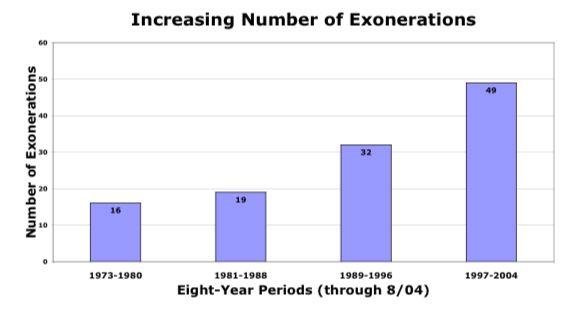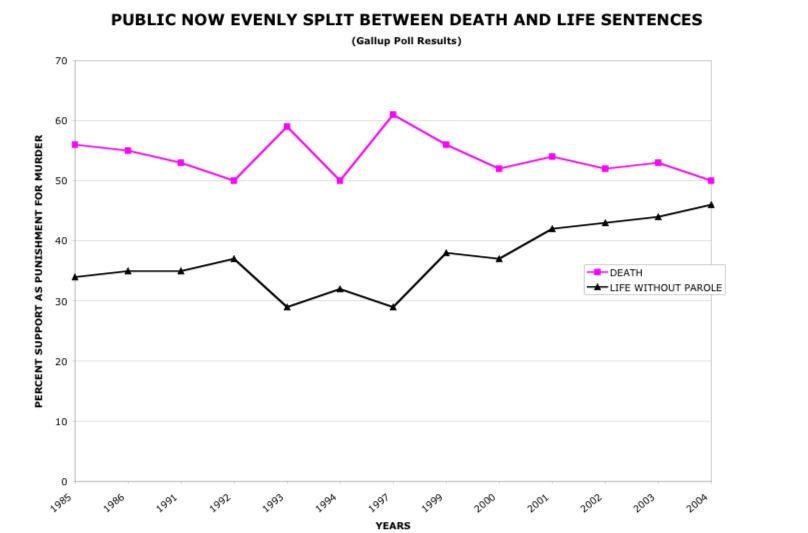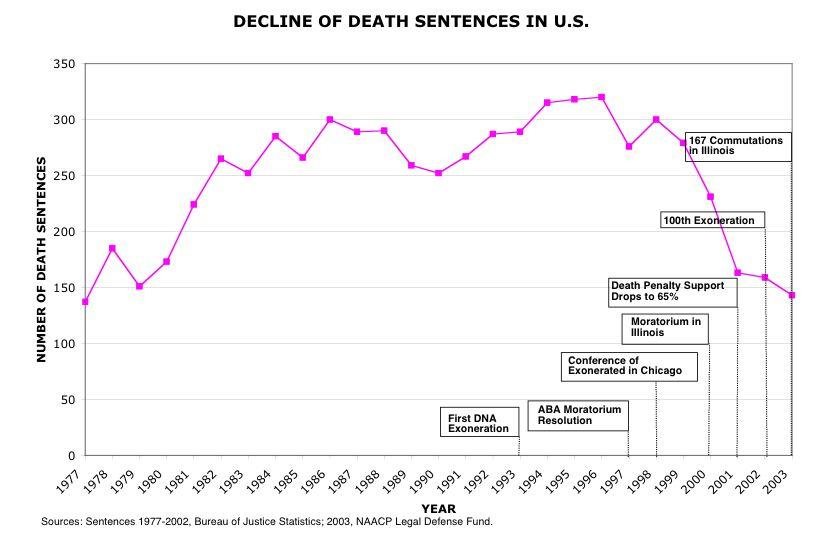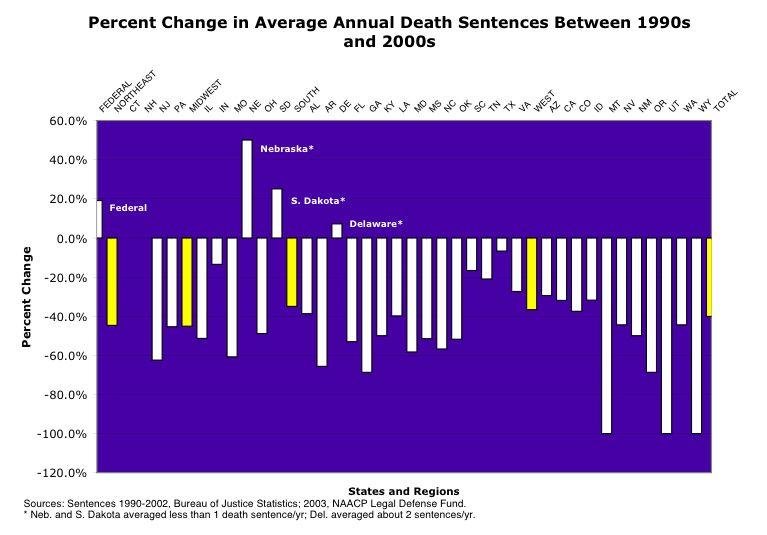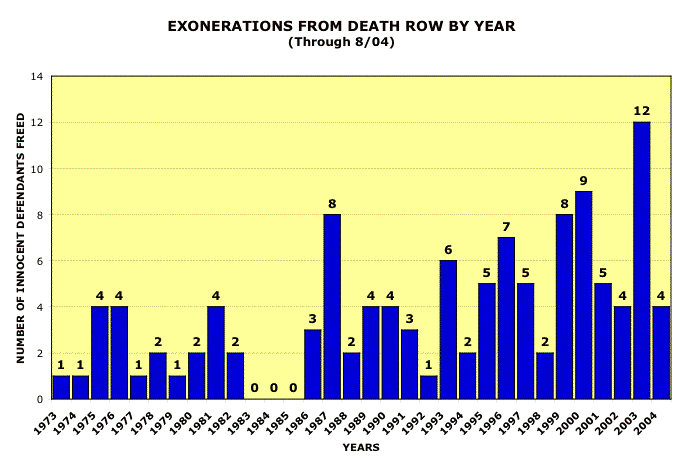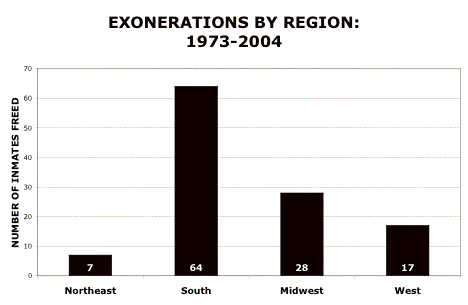Introduction
Studies suggest that the American death penalty is in a crisis. This is because of the emerging evidence, which indicates that convicts may be innocent from the charges. According to Dieter, the courts have exonerated “116 people from the death row after dropping their charges” (Dieter, 2004).
This number includes “16 people in the past 20 months” (Dieter, 2004). This shows the rate of successful appeals against the death penalty. At the same time, such successful appeals have raised concerns about the criminal justice system in the US regarding capital punishment.
Death row sentences have also declined in the last five years by more than 50 percent. Consequently, the numbers of death row inmates have also declined considerably. In addition, executions have also reduced. Further, the public support for the death penalty has also declined as studies have suggested (Dieter, 2004).
It is the innocence of some of the convicts in the death row that has created a crisis in the system. The public questions the system that should guarantee fairness. Consequently, the death penalty has met oppositions from some unlikely quarters like the judges, conservative groups, the law enforcement agency, and from some lawmakers.
However, we have to note that this crisis also has its roots in the constitutions of various States. Consequently, opponents of the death penalty have realised the need to address issues, which result from the capital punishment.
Trends indicate that the death penalty is on the decline in the US. Meanwhile, the criminal justice system has challenges from new evidence originating forensic investigations. The system should have reliable ways for the death penalty cases based on the mistakes of past convictions. The case of Ryan Mathews is an example of a successful death penalty appeal.
The case
The police arrested Ryan Mathews for “the murder of a local convenience store owner” (Dieter, 2004). This was a case in Louisiana. The court convicted the suspect in 1999 and later dismissed his charges in 2004.
The police interviewed three people who failed to identify the suspect clearly. They referred to the suspect as “short and not taller than 5’8’’ person” (Dieter, 2004). However, Mathews was at least six feet tall.
The suspect’s lawyer had not adequately prepared for the case. Consequently, he could not handle the DNA procedures and evidence as expected.
The case was difficult because the jury could not reach a verdict after many hours of deliberation and had to do it again. However, when the verdict was out, the suspect got a guilty verdict and ended in the death row list two days later.
However, in March 2003, the suspect’s attorney brought a new physical evidence for appeal. The DNA test from the ski mask did not include the suspect. The evidence brought a new suspect to the case.
In April 2004, the attorney requested for a new trial based on “the DNA evidence and argument that the prosecution suppressed evidence” (Dieter, 2004). The judge overturned the conviction. In August 9, 2004, the court officially dropped all charges against Mathews. This is how the DNA test saved Mathews from the death penalty.
The appeal process against the death sentence
This appeal process is specific to the case of Ryan Mathews who the court dropped all murder charges against after successful appeal using new evidence from the DNA test. The appeal process for a death sentence in the US depends on the new evidence presented after conviction.
Eyewitness account
The police apprehended Mathews based on descriptions of eyewitnesses. However, Mathew was slightly taller than accounts of eyewitnesses. Mathews’ arrest was a fallacy of eyewitness evidence.
According to some studies, eyewitness evidence remains “the highest cause of wrongful convictions” (Wells, 2006). It accounts for more than 75 percent of convictions, which the DNA tests and other scientific procedures prove wrong (Wells, 2006; Huff, 1987).
Most jurors believe that eyewitness evidence is reliable. However, this is not always the case. Studies suggest that we can question eyewitness evidence on three scientific grounds.
First, there is a problem of poor visibility. Second, some studies suggest that people have poor abilities for facial identification. Finally, the system relies on procedures, which are prone to bias (Bothwell, Deffenbacher and Brigham, 1987; Wells et al, 1998).
The DNA test
Most systems believe that forensic tests are infallible. Promoters of this system claim that DNA tests produce accurate results or none (Thompson, 2008). Therefore, courts have relied on DNA test results for delivering their rulings (Lazer, 2004).
The National Research Council also supports forensic DNA testing (National Research Council, 1996). The Council declared its support for the DNA testing based on the reliability and validity of tests from accurately collected and analysed data.
In the public domain, DNA testing has found its way based on post-conviction DNA test evidence and the subsequent exoneration of suspects. The DNA test results enabled Mathews to secure freedom as it brought a new suspect to the case. With such evidence on its reliability and validity, death row inmates like Mathews can secure their freedom from the criminal justice system.
Suppression of evidence
Suppression of evidence relates to “evidence that is not objectionable as violating any rule of evidence, but obtained illegally” (Udashen, 2008). In this case, the court did not bring full evidence against Mathews. Some scholars consider suppression of evidence as misconduct in the criminal justice system.
The failure of Mathews’ attorney to handle the DNA evidence effectively resulted into conviction of Mathews. This was unjust conviction based on later evidence.
The case of Mathews represents many death penalty cases where judges have reversed convictions due to suppression of evidence. The attorney discovered that the DNA testing suppressed evidence and the court was able to reopen the trial.
Suppression of evidence is a sensitive issue among judges, defence lawyers, and prosecutors. It provided a fair trial for Mathews leading to his exoneration.
Conclusion
The appeal process is not specific. However, it depends on the new type of evidence as the case of Mathews shows.
New evidence to prove innocence of a convicted death row inmate has upset the criminal justice system in the US. This trend and the rising number of cases have changed the public perception about capital punishment.
Developments in the DNA science and its applications in the criminal justice system have created news way of proving innocence in capital crimes. As a result, courts and law enforcement agencies have discovered past mistakes and set ways for appeal and new trials to prove innocence the convict.
New evidence has also promoted former advocates of the death penalty to change their opinions about it. The opinion has changed in the public domain as the number of people supporting the death penalty has dropped significantly (Radelet and Borg, 2000).
Critics of the death penalty now advocate for “life without parole as an alternative sentence” (Dieter, 2004).
Reference List
Bothwell, R, Deffenbacher, K and Brigham, J 1987, ‘Correlation of eyewitness accuracy and confidence: Optimality hypothesis revisited’, Journal of Applied Psychology, vol. 72, pp. 691-695.
Dieter, R 2004, Innocence and the Crisis in the American Death Penalty. Web.
Huff, C 1987, ‘Wrongful conviction: Societal tolerance of injustice’, Research in Social Problems and Public Policy, vol. 4, pp. 99-115.
Lazer, D 2004, DNA and the Criminal Justice System: The Technology of Justice, MIT Press, Cambridge, Mass.
National Research Council 1996, The Evaluation of Forensic DNA Evidence,National Academy Press, Washington, DC.
Radelet, M and Borg, M 2000, ‘The Changing Nature of Death Penalty Debates’, Annual Review Sociol, vol. 26, 43-61.
Thompson, W 2008, The Potential for Error in Forensic DNA Testing (and How That Complicates the Use of DNA Databases for Criminal Identification), Council for Responsible Genetics, New York.
Udashen, G 2008, Suppression of Exculpatory Evidence in Criminal Cases, The Dallas County Criminal Defense Lawyers, Dallas, Texas.
Wells, G 2006, ‘Eyewitness Identification: Systemic Reforms’, Wisconsin Law Review, vol. no. 2, pp. 1-30.
Wells, G, Small, M, Penrod, S, Malpass, R, Fulero, D and Brimacombe, C. 1998. ‘Eyewitness Identification Procedures: Recommendations for Lineups and Photospreads’, Law and Human Behavior, vol. 22, pp. 603-647.

